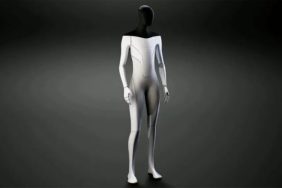Photo: Dream section of the Robots exhibition ∏ Plastiques Photography, courtesy of the Science Museum.
Some 550 years ago, Gianello Torriano got an idea in his head and set out to create the world’s first robot. Working in Toledo, Spain, he crafted an automaton monk, which could walk across a table top while moving his lips, raising a crucifix and rosary, and beating his head in contrition. Created as an offering to King Philip II of Spain, in thanks for his son’s recovery from a head injury, one imagines Torriano understood the charm of penitence by proxy.
Also: See the Universe! Check Out Highlights from the Hubble Space Telescope
Torriano made three such robots, one of which currently kicks off the timeline for a new exhibition, Robots, at the Science Museum, London, now on view through September 3, 2017. The automaton monk is a primitive example of what has become a very modern obsession with creating artificial intelligence inside a humanized form. It’s a curious pursuit, one that embraces the dystopian heart of the rise of the manmade in pursuit of mastering nature.

Entrance to the Robots exhibition ∏ Plastiques Photography, courtesy of the Science Museum
People will always be problematic because they are in possession of the will, as well as idiosyncratic forms of information processing that are more often than not grounded in irrational thought. Whereas a robot will do whatever you ask of it, and once perfected, it can do things people can never do, such as work around the clock. With every passing year robots are changing the nature of manufacturing, making people obsolete, becoming cost-effective proxies for corporate interests.
And yet, the passion and the fascination remain the same. Robots traces half a millennia of work, as it slowly took form through the twentieth century, before exponentially speeding up. A large part of the show is dedicated to the innovations of the past 17 years, revealing the way the learning curve is now taking off.

Model of Maria in the Dream section of the Robots exhibition ∏ Plastiques Photography, courtesy of the Science Museum
Consider “Inkha,” built by Matthew Walker in 2002. “She” is a reactive robotic head that tracks movements, speaks, and interacts with people in a lifelike way. With big green eyes and full red lips, “Inkha” reinforces cliche perceptions of the feminine by being sassy yet subservient, as a means to engage people in conversation and show off “her” robotic tricks.
As you peruse the exhibition, you may come to note that many of the robots on display the perceptual biases of their creators, reinforcing a queer humanness. The “female” robots are sexy or subservient; the male robots are stolid and powerful. Taken as a whole, they start to reveal why people are so intrigued by their form: children are a crapshoot but robots fall within the known.

Baxter, a working robot ∏ Plastiques Photography, courtesy of the Science Museum
The exhibition takes care to avoid the trite clichés of robots taking over the world; because let’s face it: like soldiers they’re only acting on acting on orders. The robots are proxies for a deeper impulse that lies within, a compulsion to recreate an replace the natural world with the manmade.
While there is undoubtedly something redemptive about robotic hands, restoring to life that which has been lost, these creations stand side by side with creations like the Kodomoroid communication android, which is designed to read the news—truly, a disturbing phenomenon.

Kodomoroid, a Japanese android who reads the news 2 ∏ Plastiques Photography, courtesy of the Science Museum
People acclimate entirely too easily to circumstance, and one of the few blessings in life is the ability to read body language and listen for voice modulation when hearing someone speak. By removing these elements, in the delivery of the news, we’re heading for thin ice. As the exhibition reminds us, time and again, robots are simply an extension of who we already are, guiding and shaping us by allowing curiosity to go unchecked in the name of “progress.”
Miss Rosen is a journalist covering art, photography, culture, and books. Her byline has appeared in L’Uomo Vogue, Vogue Online, Whitewall, The Undefeated, Dazed Digital, Jocks and Nerds, and L’Oeil de la Photographie. Follow her on Twitter @Miss_Rosen.








